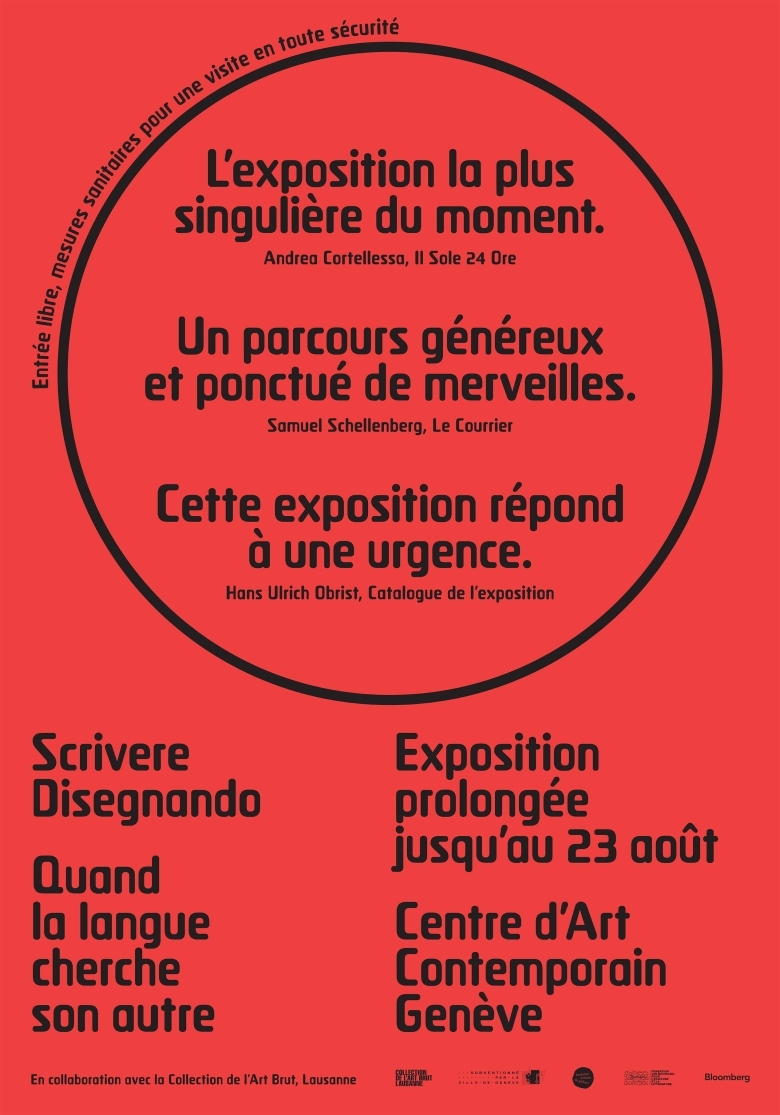
The show "Scrivere Disegnando" at Centre d'Art Contemporain, Genèva is extended until august 23.
Scrivere Disegnando
- When Language Seeks Its Other
Curated by Andrea Bellini and Sarah Lombardi
January 29 - August 23, 2020, Centre d'Art Contemporain de Genève (CAC)
Open Tuesday - Sunday, 11am - 6pm.
free entry.
PUBLIC OPENING ON JANUARY 28, 6PM
The Collection de l'Art Brut lends about 120 artworks for Scrivere Disegnando (“Writing by Drawing”), an exhibition about writing and its double. Its aim is to look back over a number of practices, from the early twentieth century to the present day, in which writing leaves the function of communication behind and moves into the sphere of the uncommunicable, the unsayable. It sets out to explore the tension inherent in script, the way that it hovers between the genuinely semantic realm and the uncharted territory of mere arabesques, automatisms, repeated marks and scribbles. All of the works on view inhabit a special terrain vague in which the act of writing is more about “trying to say” than “saying” itself, more about potentialities of meaning than about signification, to paraphrase Giorgio Agamben. It is a kind of writing that sometimes verges on delirium; it is carried beyond meaning to become an existential self-affirmation, but it is also a fanciful metaphor for the world and its mysteries.
As the very first collaborative project between the Collection de l’Art Brut in Lausanne and the Centre d’Art Contemporain Genève, this exhibition brings together a diverse range of personalities: from “outsider” artists, some of whom carried out their work while institutionalized, all the way to “official” artists, some of whom played key roles in twentieth-century avant-garde and neo-avant-garde movements. What these very different individuals have in common is the desire to capture an “elsewhere” within writing, to move past the semantic dimension and freely mine the innovative and imaginative resources of language. Another interesting aspect of this project is the significant number of female artists. Since the early twentieth century, many women have used compulsive, often illegible handwriting to express an existential need for personal affirmation, often in response to a patriarchal world that preferred them to be politically invisible and socially voiceless. In their case, writing is almost for their own consumption, written by and for themselves, in order to understand who they are and their meaning in the world. The moment of writing becomes a moment of life, a private act, a sign of existence and tool of self-knowledge.
This ambitious project includes works commissioned for the occasion from artists who have focused for some time on constructing their own “private languages.” Placed throughout the exhibition are showcases presenting an impressive selection of books and documents which allow visitors to examine the question of personal languages, secret alphabets, and indecipherable codes in relation to the history of literature.
A richly illustrated 300-page catalogue will be published in conjunction with the exhibition. It will bring together essays specially commissioned from curators, critics, artists, philosophers, and academics on the questions of asemic writing and walk the reader through these plural writings. In addition to texts by curators Andrea Bellini and Sarah Lombardi, this volume will also include contributions by Derek Beaulien (poet), Federico Campagna (philosopher), Vincent Capt (researcher), François Chastanet (architect and graphic designer), Andrea Cortellessa (literary critic), Morad Montazami (art historian), Joana Neves (curator), Marta Spagnolello (art historian), Michel Thévoz (writer, art historian, and philosopher) and Marina Yaguello (linguist). A bibliography and descriptions of the works of more than one hundred artists round out the publication.
With works by: Vincenzo Accame, Rosaire Appel, Tchello d’Barros, Roland Barthes, Gianfranco Baruchello, Tomaso Binga, Irma Blank, Nick Blinko, Alighiero Boetti, Marcia Brauer, Frédéric Bruly-Bouabré, Elijah Burgher, Axel Calatayud, Gaston Chaissac, Laura Cingolani, Guy de Cointet, Aloïse Corbaz, Dadamaino, Betty Danon, Hanne Darboven, Michel Dave, Michael Dean, Mirtha Dermisache, Emmanuel Derriennic, Jean Dubuffet, Giordano Falzoni, León Ferrari, Chiara Fumai, Pepe Gaitán, Jill Galliéni, Ryan Gander, Anne-Marie Gbindoun, Marco Giovenale, Rafael González, Josef Grebing, Mariangela Guatteri, Gustav, Elisabetta Gut, Brion Gysin, Emma Hauck, Takanori Herai, Joseph Heuer, Susan Hiller, Steffani Jemison, Carlo Keshishian, Annalies Klophaus, Maria Lai, Fabio Lapiana, Louise Lavallée-Tournay, Jürg Lehni, Dwight Mackintosh, Kunizo Matsumoto, Viviane Van Melkebebeeke, Reinhold Metz, Henri Michaux, Miriam Midley, Bruno Munari, JB Murray, Francis Palanc, Giulio Paolini, Luca Maria Patella, Enzo Patti, Jean Perdrizet, Nathalie Perrin, Laure Pigeon, Renata Prunas, Justine Python, Svetlana Rabey, Carmen Racovitza, Judit Reigl, Jane Ruffié, Valeri Scherstjanoi, Salome Schmuki, Greta Schödl, Luigi Serafini, Jeremy Shaw, Hélène Smith, Ivana Spinelli, Martina Stella, Lina Stern, Laurence Sterne, Barbara Suckfüll, Jenna Sutela, Cecil Touchon, Jeanne Tripier, Pascal Vonlanthen, August Walla, Robert Walser, Galaxia Wang, Melvin Way, and Adolf Wölfli.
Cover image : Scrivere Disegnando. quand la langue cherche son autre written in the typeface Set in Stone by Ryan Gander.
Link to Samuel Schellenberg's article in "le Courrier", february 7, 2020
Press review
Lien vers l'article de la Tribune de Genève du 3 mars 2020
Lien vers l'article du Temps du 5 mars 2020
Lien vers l'article de Artforum du mois d'avril 2020
Lien vers l'article de Claire Margat dans La Quinzaine littéraire du mois d'avril
Lien vers l'article d'Etienne Dumont, Bilan, 18 mai 2020
Lien vers l'article de Claire Margat, Artpress juin 2020
Lien vers l'article d'Eward M. Gòmez, août 2020
Publish Date: 10.08.2020